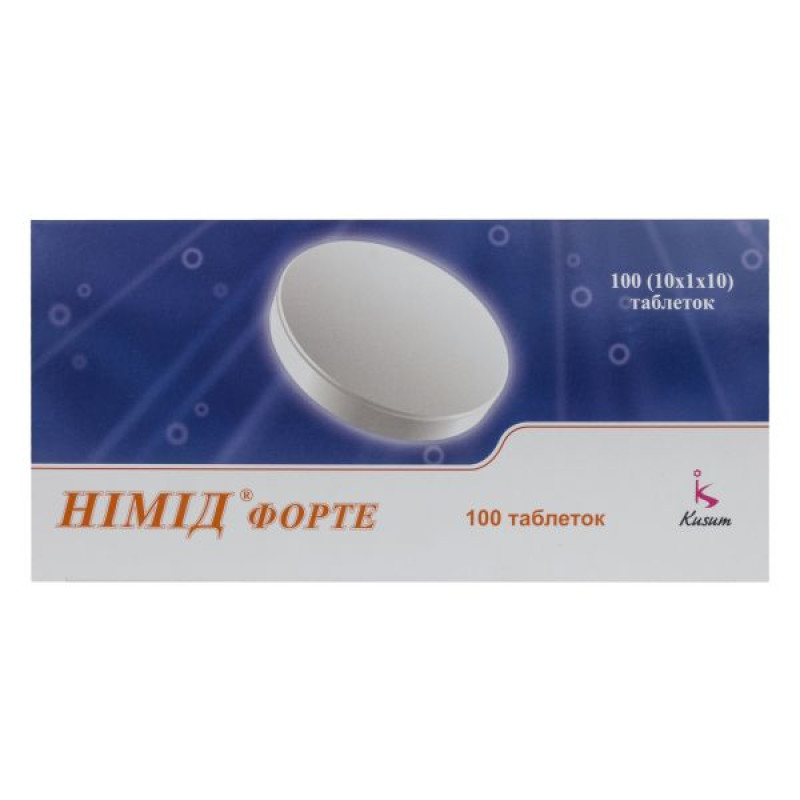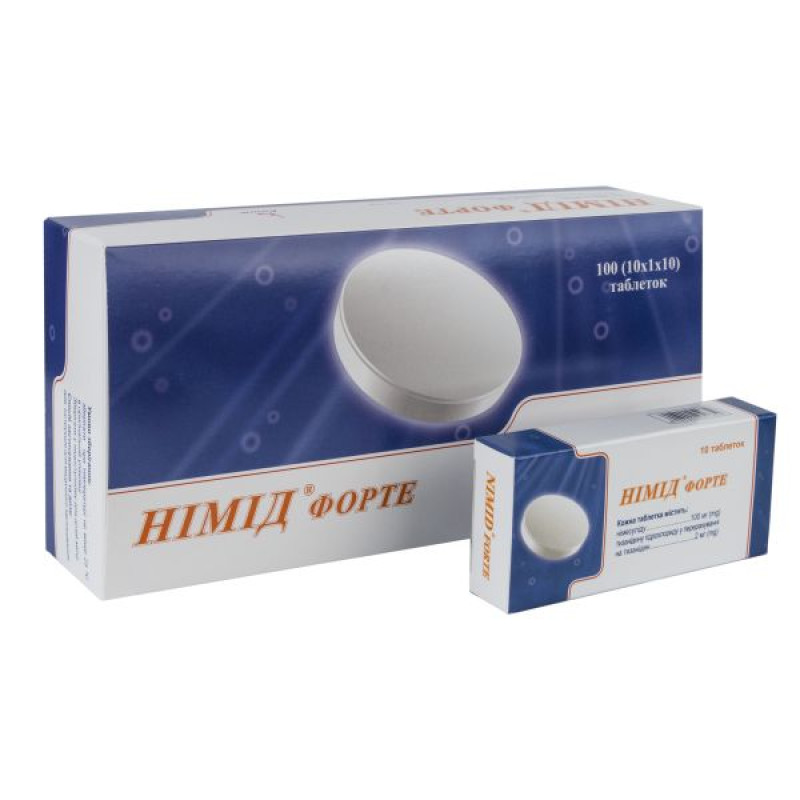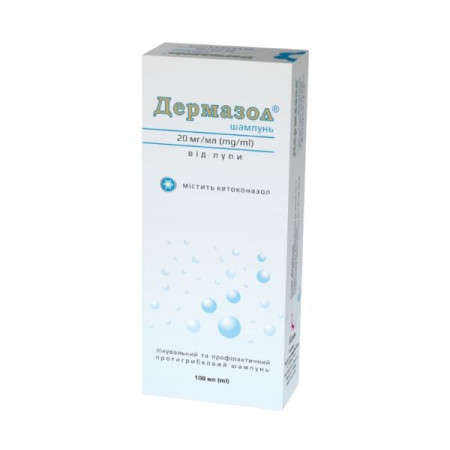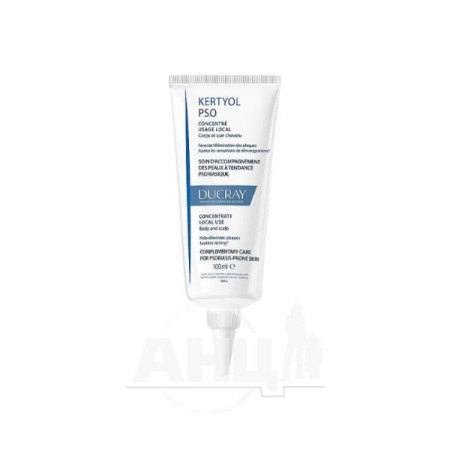Nimid forte tablets No. 100
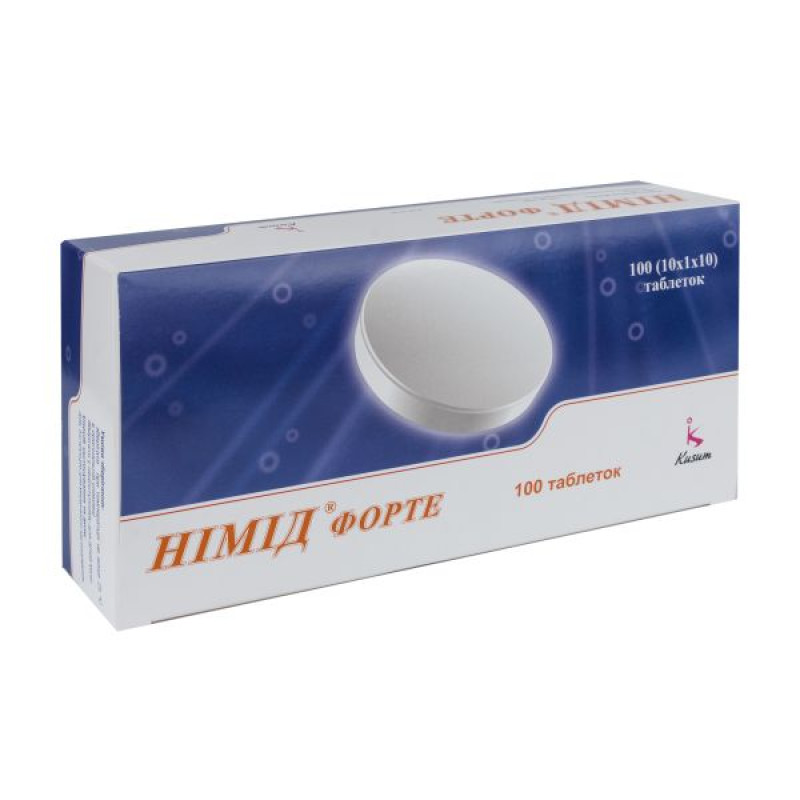
Instructions for Nimid forte tablets No. 100
Composition
active ingredients: nimesulide, tizanidine hydrochloride;
1 tablet contains nimesulide 100 mg, tizanidine hydrochloride equivalent to tizanidine 2 mg;
Excipients: microcrystalline cellulose, croscarmellose sodium, magnesium stearate, colloidal anhydrous silicon dioxide.
Dosage form
Pills.
Main physicochemical properties: round tablets of light yellow color, smooth on one side and embossed with "NF" on the other.
Pharmacotherapeutic group
Nonsteroidal anti-inflammatory and antirheumatic drugs.
ATX code M01A.
Pharmacological properties
Pharmacodynamics
Nimid® Forte is a combination drug that combines two drugs: a nonsteroidal anti-inflammatory drug (NSAID) from the methanesulfonanilide group - nimesulide and a centrally acting skeletal muscle relaxant - tizanidine.
Mechanism of action of nimesulide.
Nimesulide exhibits anti-inflammatory, analgesic and antipyretic effects. The therapeutic effect of nimesulide is due to the fact that it interacts with the arachidonic acid cascade and reduces prostaglandin biosynthesis by inhibiting cyclooxygenase.
Mechanism of action of tizanidine.
Tizanidine is a centrally acting muscle relaxant whose main site of action is the spinal cord. By stimulating presynaptic α-2-adrenoreceptors, it inhibits the release of amino acids that stimulate N-methyl-D-aspartate receptors (NMDA receptors). As a result, polysynaptic signal transmission responsible for excessive muscle tone at the level of interneuronal connections is inhibited in the spinal cord, and muscle tone is reduced. Tizanidine is effective both in acute painful muscle spasms and in chronic spasticity of spinal and cerebral origin. It reduces resistance to passive movements, suppresses spasm and clonic seizures, and improves the strength of active muscle contractions.
Pharmacokinetics
Nimesulide.
In humans, nimesulide is well absorbed after oral administration, reaching a maximum plasma concentration after 2-3 hours. Up to 97.5% of nimesulide is bound to plasma proteins. Nimesulide is actively metabolized in the liver with the participation of CYP2C9, an isoenzyme of cytochrome P 450. The main metabolite is a parahydroxy derivative, which also has pharmacological activity. The half-life is from 3.2 to 6 hours. Nimesulide is excreted from the body with urine - about 50% of the dose taken. About 29% of the dose taken is excreted with feces in a metabolized form. Only 1-3% is excreted from the body unchanged. The pharmacokinetic profile in elderly patients does not change.
Tizanidine.
Tizanidine is rapidly absorbed. Peak plasma concentrations are reached approximately 1 hour after administration. The mean absolute bioavailability is 34%. Plasma protein binding is 30%. The drug undergoes rapid and extensive metabolism in the liver. The metabolites are inactive. They are excreted mainly by the kidneys (70%), about 2.7% of tizanidine is excreted unchanged.
In patients with renal insufficiency (creatinine clearance less than 25 ml/min), the mean maximum plasma concentration is twice that of healthy volunteers, and the terminal half-life is prolonged to approximately 14 hours, resulting in an average 6-fold increase in the area under the concentration-time curve (AUC).
Tizanidine is metabolized by the CYP1A2 isoenzyme in the liver. Patients with impaired liver function may experience higher plasma concentrations of the substance.
Pharmacokinetic data in elderly patients are limited.
Indication
Acute pain caused by skeletal muscle spasm. Ankylosing spondylitis. Vertebralgia.
Contraindication
Hypersensitivity to the active substances, to any other NSAID or to any of the excipients of the medicinal product.
History of hypersensitivity reactions (bronchospasm, rhinitis, urticaria) when using acetylsalicylic acid or other NSAIDs.
Peptic ulcer in the acute phase, history of ulcer, perforation or bleeding in the digestive tract.
History of gastrointestinal bleeding or perforation associated with previous use of NSAIDs.
History of cerebrovascular bleeding or other hemorrhages, as well as diseases accompanied by bleeding.
History of hepatotoxic reactions to nimesulide; concomitant use of other substances with potential hepatotoxic effects.
Liver dysfunction.
Severe blood clotting disorders.
Severe heart failure.
Severe renal impairment.
Alcoholism; drug addiction.
Elevated body temperature and/or flu-like symptoms.
Suspicion of acute surgical pathology.
Concomitant use with potent CYP1A2 inhibitors such as fluvoxamine and ciprofloxacin.
Childhood.
Third trimester of pregnancy and breastfeeding (see sections “Use during pregnancy or breastfeeding”).
Interaction with other medicinal products and other types of interactions
Interactions associated with nimesulide.
Pharmacodynamic interactions.
the risk of gastrointestinal ulcers or bleeding increases (see section "Special warnings and precautions for use").
Antiplatelet agents and selective serotonin reuptake inhibitors (SSRIs): increased risk of gastrointestinal bleeding (see section "Special warnings and precautions for use").
Anticoagulants: NSAIDs may enhance the effect of anticoagulants such as warfarin (see section "Special instructions"). When treating patients with nimesulide who are taking warfarin or similar anticoagulants or acetylsalicylic acid, there is an increased risk of bleeding complications. Therefore, this combination is not recommended (see section "Special instructions"), and is contraindicated in patients with severe coagulation disorders (see section "Contraindications"). If combination therapy cannot be avoided, careful monitoring of blood coagulation parameters is necessary.
Diuretics, angiotensin-converting enzyme (ACE) inhibitors and angiotensin II antagonists (AII): NSAIDs may reduce the effect of diuretics and other antihypertensive drugs. In some patients with reduced renal function (e.g. dehydrated patients or elderly patients with impaired renal function), the concomitant use of ACE inhibitors and cyclooxygenase inhibitors may lead to further deterioration of renal function, including the occurrence of acute renal failure, which is usually reversible. These interactions should be considered when the patient uses Nimid® Forte in combination with ACE inhibitors or AII.
Therefore, this combination should be administered with caution, especially in elderly patients. Patients should be adequately hydrated. The need for monitoring renal function after initiation of concomitant treatment and the need for periodic monitoring after discontinuation should be considered.
Other non-steroidal anti-inflammatory drugs (NSAIDs): The concomitant use of nimesulide-containing medicinal products (see section "Clinical characteristics") with other NSAIDs, including acetylsalicylic acid at anti-inflammatory doses (≥ 1 g as a single dose or ≥ 3 g per day), is not recommended.
Pharmacokinetic interactions: the effect of nimesulide on the pharmacokinetics of other drugs
Furosemide: in healthy volunteers, nimesulide temporarily weakens the effect of furosemide on sodium excretion and, to a lesser extent, potassium excretion, and also reduces the diuretic effect. Simultaneous use of nimesulide and furosemide leads to a decrease (approximately 20%) in the area under the concentration-time curve (AUC) and cumulative excretion of furosemide without changing its renal clearance.
The combined use of furosemide and nimesulide-containing drugs in patients with impaired renal or cardiac function requires caution (see section "Special warnings and precautions for use").
Lithium: NSAIDs have been reported to reduce lithium clearance, leading to increased plasma lithium levels and lithium toxicity. When nimesulide is prescribed to a patient receiving lithium therapy, careful monitoring of plasma lithium levels is recommended.
Pharmacokinetic interactions: the effect of other drugs on the pharmacokinetics of nimesulide
In vitro studies have shown that nimesulide is displaced from its binding sites by tolbutamide, salicylic acid and valproic acid. However, despite the possible effect on its plasma concentration, such interactions are not clinically significant.
Other interactions
Possible pharmacokinetic interactions with glibenclamide, theophylline, warfarin, digoxin, cimetidine and antacids (aluminium and magnesium hydroxide combination) have also been investigated in vivo. No clinically significant interactions were observed.
Nimesulide inhibits the activity of the CYP2C9 enzyme. Plasma concentrations of drugs that are substrates of this enzyme may increase with simultaneous use of Nimid® Forte. Caution should be exercised when nimesulide is used less than 24 hours before or less than 24 hours after taking methotrexate, as it is possible to increase the serum level of the latter and increase its toxicity.
Due to their effects on renal prostaglandins, prostaglandin synthetase inhibitors such as nimesulide may increase the nephrotoxicity of cyclosporines.
Interactions associated with tizanidine.
CYP1A2 inhibitors: Concomitant use of known CYP1A2 inhibitors may increase tizanidine plasma levels.
Increased plasma levels of tizanidine may lead to symptoms of overdose, such as QT prolongation.
Potent CYP1A2 inhibitors: Concomitant use of potent CYP1A2 inhibitors such as fluvoxamine or ciprofloxacin with tizanidine is contraindicated (see section 4.3). Concomitant use of tizanidine with fluvoxamine increases the AUC of tizanidine by 33-fold, while concomitant use of tizanidine with ciprofloxacin increases the AUC of tizanidine by 10-fold. This may lead to a clinically significant and prolonged decrease in blood pressure, accompanied by drowsiness, dizziness and decreased psychomotor performance (see section 4.4).
Other CYP1A2 inhibitors: Concomitant use of tizanidine with other CYP1A2 inhibitors, such as antiarrhythmics (amiodarone, mexiletine, propafenone), cimetidine, some fluoroquinolones (enoxacin, pefloxacin, norfloxacin), rofecoxib, oral contraceptives and ticlopidine, is not recommended.
Increased plasma levels of tizanidine may be manifested by symptoms of overdose, including QT prolongation (see section "Overdose").
Antihypertensives (including diuretics): Concomitant use with tizanidine may occasionally cause hypotension and bradycardia. In some patients receiving concomitant antihypertensive therapy, rebound hypertension and rebound tachycardia have been observed upon abrupt withdrawal of tizanidine. In isolated cases, rebound hypertension may lead to stroke (see sections 4.4 and 4.8).
Caution should be exercised when co-administering tizanidine with drugs that prolong the QT interval.
Rifampicin: Concomitant use of tizanidine with rifampicin may result in a 50% decrease in tizanidine concentrations. Thus, the therapeutic effect may be reduced when rifampicin is used during tizanidine therapy, which may be clinically significant in some patients. Prolonged concomitant use should be avoided, and if necessary, dosage adjustments should be made with great caution. Careful dose adjustments (dose increases) are necessary if long-term combination therapy is planned.
Smoking. Tizanidine administration results in a 30% reduction in systemic exposure in men who smoke (more than 10 cigarettes per day). Long-term use of tizanidine in men who smoke heavily requires higher doses.
Centrally acting drugs (sedatives and hypnotics (benzodiazepine or baclofen), some antihistamines, general anesthetics and analgesics, psychotropic drugs, narcotics): simultaneous use with tizanidine may enhance the effects of each drug and increase the hypnotic effect of tizanidine.
Alcohol: During therapy with the drug Nimid® Forte, alcohol should be avoided, as the effect of tizanidine may change unpredictably and the risk of adverse reactions increases. The depressant effect of alcohol on the central nervous system may be enhanced by tizanidine.
α-2 adrenergic agonists (e.g. clonidine): Concomitant administration of tizanidine should be avoided due to the potential additive hypotensive effect.
Application features
Features of use associated with nimesulide.
Adverse reactions can be minimized by using the lowest effective dose for the shortest period of time necessary to control symptoms (see section “Method of administration and dosage” and on gastrointestinal and cardiovascular risks below).
If treatment is ineffective, therapy should be discontinued.
Concomitant use of nimesulide with NSAIDs, including selective cyclooxygenase-2 inhibitors, should be avoided. Patients should be advised to refrain from taking other analgesics during nimesulide therapy.
During treatment with nimesulide, it is recommended to avoid the simultaneous use of hepatotoxic drugs and to refrain from drinking alcohol.
The use of NSAIDs may mask fever associated with an underlying bacterial infection.
Effect on the liver
Serious hepatic reactions have been reported rarely with nimesulide, including very rare fatal cases (see also section "Adverse reactions"). Patients who develop symptoms suggestive of hepatic injury during nimesulide treatment, such as anorexia, nausea, vomiting, abdominal pain, fatigue, dark urine, or patients whose liver function tests deviate from normal values, should discontinue therapy. Nimesulide should not be re-administered to such patients. Liver injury, most of which is reversible, has been reported after short-term exposure to the drug.
Patients taking nimesulide who develop fever and/or flu-like symptoms should discontinue treatment.
Gastrointestinal bleeding or ulceration/perforation (with or without warning symptoms or a history of serious gastrointestinal events), which can be fatal, has been reported with any NSAID. The risk of gastrointestinal bleeding, ulceration or perforation increases with increasing NSAID doses, in patients with a history of ulcer, particularly if complicated by bleeding or perforation (see section 4.3), and in the elderly. In such patients, treatment should be initiated at the lowest possible dose. For these patients, as well as for those who require concomitant use of low doses of acetylsalicylic acid or other drugs that increase the risk of gastrointestinal complications, combination therapy with protective agents, such as misoprostol or proton pump inhibitors, should be considered (see information below and section “Interaction with other medicinal products and other forms of interaction”).
Patients with a history of toxic gastrointestinal lesions, especially elderly patients, should report any unusual abdominal symptoms (especially gastrointestinal bleeding), especially in the initial stages of treatment.
Gastrointestinal bleeding or ulceration/perforation, with or without warning symptoms or a history of serious gastrointestinal events, may occur at any time during treatment. If gastrointestinal bleeding or ulceration occurs, nimesulide should be discontinued. Nimesulide should be used with caution in patients with gastrointestinal disorders, including a history of peptic ulcer, gastrointestinal bleeding, ulcerative colitis or Crohn's disease (see section 4.8).
Patients taking concomitant medications that may increase the risk of ulceration or bleeding, such as oral corticosteroids, anticoagulants, including warfarin, selective serotonin reuptake inhibitors, or antiplatelet agents such as acetylsalicylic acid, should be advised to exercise caution.
If bleeding or ulcers of the digestive tract occur in patients receiving nimesulide, treatment should be discontinued.
NSAIDs should be prescribed with caution to patients with a history of gastrointestinal disease (ulcerative colitis, Crohn's disease), as its exacerbation is possible (see section "Adverse reactions").
Concomitant use of nimesulide with other drugs, such as oral contraceptives, anticoagulants, antiplatelet agents, may cause exacerbation of Crohn's disease and other diseases of the digestive tract.
Effects on the cardiovascular and cerebrovascular systems
Patients with hypertension and/or a history of mild to moderate congestive heart failure require appropriate monitoring and medical advice, as fluid retention and edema have been reported with NSAID therapy.
There is evidence to suggest that the use of some NSAIDs, particularly at high doses and in long-term treatment, may be associated with a small increased risk of arterial thrombotic events, such as myocardial infarction or stroke. There is insufficient evidence to exclude such a risk with nimesulide.
Patients with uncontrolled hypertension, congestive heart failure, established ischemic heart disease, peripheral arterial disease and/or cerebrovascular disease should be treated with nimesulide only after careful assessment. A similar assessment should be carried out before starting long-term treatment in patients with risk factors for cardiovascular disease, such as hypertension, hyperlipidemia, diabetes mellitus, smoking.
Since nimesulide may affect platelet function, it should be used with caution in patients with hemorrhagic diathesis (see also section "Contraindications"). However, nimesulide cannot replace acetylsalicylic acid in the prevention of cardiovascular diseases.
Effects on the kidneys
Caution should be exercised in patients with impaired renal function or heart failure, as the use of nimesulide may lead to deterioration of renal function. In the event of such deterioration, treatment should be discontinued (see also section "Interaction with other medicinal products and other forms of interaction").
Elderly patients
Elderly patients may be more likely to experience adverse reactions to NSAIDs, especially gastrointestinal bleeding and perforation, in some cases fatal (see section 4.8), and to have impaired renal, cardiac and hepatic function, and appropriate clinical monitoring is recommended.
Serious skin reactions, some of which have been fatal, including exfoliative dermatitis, Stevens-Johnson syndrome and toxic epidermal necrolysis, have been reported very rarely in association with the use of NSAIDs (see section 4.8). Patients appear to be at greatest risk of developing such reactions at the start of treatment, with most reactions occurring within the first month of therapy. Nimesulide should be discontinued at the first appearance of skin rash, mucosal lesions or any other sign of hypersensitivity.
Cases of fixed drug eruption (FDE) have been reported with nimesulide. Nimesulide should not be re-administered to patients with a history of FDE associated with nimesulide (see section 4.8).
Impact on fertility.
The use of nimesulide may impair female fertility and is not recommended in women attempting to conceive. Women who have difficulty conceiving or who are undergoing investigation for infertility should consider discontinuing Nimid® Forte (see section “Use during pregnancy or lactation”).
Features of use associated with tizanidine.
The concomitant use of moderate CYP1A2 inhibitors with tizanidine is not recommended (see sections “Interaction with other medicinal products and other types of interactions” and “Contraindications”).
After abrupt withdrawal of tizanidine and/or concomitant use of antihypertensive drugs, patients may experience rebound hypertension. In such circumstances, patients may develop hypertension and tachycardia. In some cases, such rebound hypertension may lead to stroke. Tizanidine treatment should not be discontinued abruptly, but only by gradually reducing the dose (see sections "Interaction with other medicinal products and other forms of interaction" and "Adverse reactions").
In patients with renal insufficiency (creatinine clearance < 25 ml/min), systemic exposure to tizanidine may be up to six times higher, therefore severe renal impairment (creatinine clearance < 30 ml/min) is a contraindication to the use of Nimid® Forte (see section “Method of administration and dosage”).
Hepatic failure has been reported in association with tizanidine, but has been rare in patients receiving daily doses up to 12 mg. Therefore, monitoring of liver function is recommended in patients with clinical symptoms suggestive of hepatic failure (such as nausea, loss of appetite, or unexplained fatigue). Nimid® Forte should be discontinued if serum ALT or AST levels exceed 3 times the upper limit of normal for a prolonged period.
Hypersensitivity reactions, including anaphylaxis, angioedema, dyspnoea, dermatitis, rash, urticaria, pruritus and erythema, have been reported with tizanidine. Close monitoring of patients is recommended for one to two days after the first dose of tizanidine. In the event of anaphylaxis or angioedema with anaphylactic shock or dyspnoea, Nimid® Forte should be discontinued immediately and the patient should be given appropriate treatment. Hypotension may occur with tizanidine and as a result of drug interactions with CYP1A2 inhibitors and/or antihypertensive drugs (see sections “Interaction with other medicinal products and other forms of interaction” and “Adverse reactions”). Severe manifestations of hypotension, such as loss of consciousness and circulatory collapse, have been reported.
Caution should be exercised when using Nimid® Forte together with drugs that prolong the QT interval (such as cisapride, amitriptyline, azithromycin) (see section “Interaction with other medicinal products and other types of interactions”).
Caution is required in patients with ischemic heart disease and/or heart failure. Regular ECG monitoring should be performed at the beginning of the use of Nimid® Forte in such patients.
Before using this drug in patients with myasthenia gravis, the risk/benefit ratio should be carefully assessed.
Experience in children and adolescents is limited, and therefore the use of Nimid® Forte is not recommended for this category of patients.
Caution should be exercised when using this drug in elderly patients.
Features of use associated with the drug Nimid® Forte.
Excipients
This medicinal product contains less than 1 mmol (23 mg) sodium/dose, i.e. essentially 'sodium-free'.
Use during pregnancy or breastfeeding
Pregnancy
Use of nimesulide
Inhibition of prostaglandin synthesis may adversely affect pregnancy and/or embryo/foetal development. Epidemiological data suggest that use of prostaglandin synthesis inhibitors in early pregnancy may increase the risk of miscarriage and of fetal heart defects and gastroschisis. The absolute risk of cardiovascular malformations increases from less than 1% to approximately 1.5%. The risk is believed to increase with increasing dose and duration of therapy.
In animals, the use of a prostaglandin synthesis inhibitor has resulted in increased pre- and post-implantation losses and increased embryo-fetal mortality. In addition, it has been reported that animals treated with a prostaglandin synthesis inhibitor during organogenesis have an increased incidence of various fetal malformations, including cardiovascular malformations.
The use of nimesulide from the 20th week of pregnancy may cause oligohydramnios due to fetal renal dysfunction. This may occur shortly after the start of treatment and is usually reversible after discontinuation of the drug. In addition, there are reports of cases of fetal ductus arteriosus narrowing after intrauterine exposure to nimesulide in the second trimester of pregnancy, most of which resolved after discontinuation of treatment. Therefore, during the first and second trimesters of pregnancy, nimesulide should not be administered unless clearly necessary. If nimesulide is used by women attempting to conceive or during the first and second trimesters of pregnancy, the dose should be as low as possible and the duration of treatment as short as possible. Antenatal monitoring for oligohydramnios and ductus arteriosus in the fetus should be considered after exposure to nimesulide for several days, starting from the 20th week of pregnancy. Nimesulide should be discontinued if oligohydramnios or ductus arteriosus in the fetus is detected.
In the third trimester of pregnancy, all prostaglandin synthesis inhibitors may lead to the development of the following in the fetus:
pneumocardiac toxic lesion (premature narrowing/closure of the ductus arteriosus and pulmonary hypertension);
kidney dysfunction (see above);
In the mother at the end of pregnancy and the newborn, it is possible:
increased bleeding time, anti-aggregation effect, which can occur even when using very low doses;
suppression of uterine contractile activity, leading to delayed or prolonged labor.
Uses of tizanidine
Women of reproductive age who are sexually active should have a pregnancy test before starting treatment with tizanidine. Women of reproductive age should be advised that animal studies have shown that tizanidine is harmful to the fetus. Women of reproductive age who are sexually active should use effective contraception (methods that allow pregnancy in less than 1% of cases) during the entire period of treatment with tizanidine and for one day after its discontinuation.
Data on the use of tizanidine in pregnant women are limited, so it should not be prescribed during pregnancy unless the potential benefit to the mother outweighs the potential risk to the fetus. Tizanidine is not teratogenic in rats and rabbits, but it causes difficulty in delivery, increased prenatal and postnatal mortality, and delayed fetal development in rats.
Breastfeeding period.
Use of nimesulide
It is not known whether nimesulide is excreted in human milk. Nimesulide is contraindicated during breastfeeding (see section "Contraindications").
Uses of tizanidine
No teratogenic effects were observed when tizanidine was used in rats and rabbits. The risk to the breastfed child should be considered. Animal studies have shown that tizanidine passes into breast milk in small amounts. Therefore, tizanidine should not be administered to breastfeeding women.
Fertility
Use of nimesulide
As with other NSAIDs, nimesulide-containing products are not recommended in women attempting to conceive (see section 4.4). Women who have difficulty conceiving or are undergoing investigation of infertility should discontinue nimesulide.
If pregnancy is established while using nimesulide, the doctor should be informed.
Uses of tizanidine
No impairment of fertility was observed in male rats treated with tizanidine at a dose of 10 mg/kg/day or in female rats treated with 3 mg/kg/day. Impaired fertility was observed in male rats treated with tizanidine at a dose of 30 mg/kg/day and in female rats treated with 10 mg/kg/day. Sedation, weight loss, and ataxia were also observed at these doses.
Women of reproductive age
Uses of tizanidine
Women of childbearing potential should be advised that animal studies have shown that tizanidine is harmful to the fetus. Women of childbearing potential who are sexually active should use effective contraception (methods that result in less than 1% pregnancy) during and for one day after stopping tizanidine.
Ability to influence reaction speed when driving vehicles or other mechanisms
Related to nimesulide
Studies on the effect of medicines containing nimesulide on the ability to drive or use machines have not been conducted, however, patients who experience dizziness, vertigo or drowsiness after taking nimesulide should refrain from driving or using machines.
Tizanidine-related
Even when prescribed as recommended, tizanidine may cause drowsiness, dizziness and/or hypotension, thus impairing the patient's ability to drive and use machines. The risks are increased by concomitant use of alcohol.
Therefore, you should refrain from activities that require high concentration of attention and quick reactions, such as driving vehicles or working with machines and mechanisms.
Method of administration and doses
In order to prevent and reduce the occurrence of adverse reactions, the drug should be taken for the shortest possible time and in the minimum effective dose. The drug should be prescribed only after a careful assessment of the risk/benefit ratio.
The drug should be taken orally after meals at the same time of day, with sufficient fluid.
The maximum duration of treatment is 15 days.
Adults. 1 tablet 2 times a day - morning and evening. After achieving the analgesic effect, the use of the drug should be discontinued.
Elderly patients: No dose adjustment is required. However, caution should be exercised when administering the drug to this category of patients.
Patients with renal impairment. For patients with mild or moderate renal impairment (creatinine clearance 30-80 ml/min), no dose adjustment is required, while severe renal impairment (creatinine clearance < 30 ml/min) is a contraindication to the use of Nimid® Forte (see sections “Contraindications” and “Pharmacokinetics”).
Patients with impaired liver function. The use of Nimid® Forte is contraindicated in patients with impaired liver function (see section "Pharmacokinetics"). Adverse reactions can be minimized by using the drug for the shortest period of time necessary to control symptoms (see section "Special instructions").
Children
The drug is contraindicated in children.
Overdose
Nimesulide overdose
Symptoms of acute NSAID overdose are usually limited to: apathy, drowsiness, nausea, vomiting and epigastric pain, which are usually reversible with supportive therapy. Gastrointestinal bleeding may occur. Rarely, arterial hypertension, acute renal failure, respiratory depression and coma may occur. Anaphylactoid reactions have been reported with therapeutic doses of NSAIDs, which may occur with overdose. In case of NSAID overdose, patients should be provided with symptomatic and supportive treatment. There are no specific antidotes. There is no information on the removal of nimesulide by hemodialysis, but taking into account its high degree of binding to plasma proteins (up to 97.5%), dialysis is unlikely to be effective in overdose. If symptoms are present or after severe overdose within 4 hours of taking the drug, patients may be induced to vomit and/or given activated charcoal (60–100 g for adults) and/or an osmotic laxative. Forced diuresis, urine alkalinization, hemodialysis or hemoperfusion may be ineffective due to the high degree of protein binding. Renal and hepatic function should be monitored.
Tizanidine overdose
Symptoms: nausea, vomiting, hypotension, bradycardia, QT prolongation, dizziness, miosis, respiratory distress, coma, restlessness, drowsiness.
Treatment: multiple high-dose administration of activated charcoal is recommended to remove the drug from the body. Forced diuresis may accelerate the elimination of the drug. Further symptomatic treatment should be carried out.
Adverse reactions
Adverse reactions associated with nimesulide
From the side of the circulatory and lymphatic systems: anemia, eosinophilia, thrombocytopenia, pancytopenia, purpura.
Immune system disorders: hypersensitivity, anaphylaxis.
Metabolic disorders: hyperkalemia.
On the part of the psyche: feeling of fear, nervousness, night terrors.
Nervous system: dizziness, headache, drowsiness, encephalopathy (Reye's syndrome), stroke.
From the organs of vision: blurred vision, visual disturbances.
From the organs of hearing and balance: vertigo (dizziness).
Cardiovascular system: tachycardia, hypertension, hemorrhage, blood pressure lability, hot flashes, heart failure, heart attack.
Respiratory, thoracic and mediastinal disorders:
There are no reviews for this product.
There are no reviews for this product, be the first to leave your review.
No questions about this product, be the first and ask your question.







